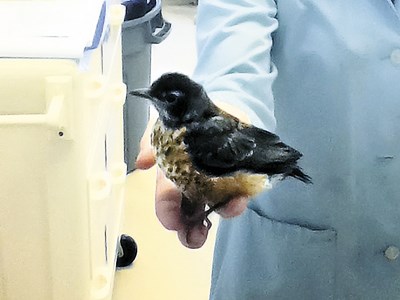I never knew it could be so easy to domesticate an animal. All it takes is a consistent supply of food and a reasonable amount of trust. After Robin Wood flew onto the back of our cat, I knew his days would be numbered if we didn’t reintegrate him into the wild.
And in all honesty, I was looking forward to a renewed worm population in my garden and later mornings lolling in bed; show me a songbird that doesn’t wake up before 6 a.m. and I’ll buy you lunch.
The morning after Orson left for Toronto, I awoke to loud chirping. It was 5 a.m., Sunday, and there was a bird sitting on my head.
I recall now how my mother felt, 35 years earlier, when my diapered brother, with his mouthful of blackened apple juice teeth, would yell from the top if the stairs at the baby gate: “Juice!” and hurl the glass bottle passionately towards the source, smashing it.
Approaching 8 a.m., I still hadn’t found ample food for Robin. His cries, piercing my heart, moved me to desperation. I called the Wild at Heart Animal Refuge in Walden and plead my case.
“Where is he now?” they inquired. “Atop my head,” was my solemn reply. They urged me to bring him out.
Volunteer Kayla Guse, met us at the entrance and commented on Robin Wood’s friendly cry.
You have no idea, I thought. She assigned Robin a case number and promised to reintroduce him to bird life by bunking him up with a younger Robin. “We don’t hand feed, since we want them to be able to scavenge for food on their own.”
They promised that, despite being caged, they would offer “cage enrichments,” such as branches with buds and leaves and live insects to scavenge. “Our goal is to have them not associate humans with food,” said volunteer Kayla Sebalj, who seemed amused by my anxious maternal ways.
Can you ever really undomesticate an animal? What I’m really asking, I guess, is would Robin Wood ever return to our big blue spruce and raise up a family?
Would he remember us and the time we spent by the Azalea, turning over stones and digging through carefully placed mulch? I imagined he wouldn’t, but we would.
It’s been a week or more since we dropped Robin off at the refuge. I thought I should call in and check on his progress. “Case number?” “479.” “Ahh, the friendly one!”
“We made him that way,” I wanted to shout; “He’s just like his mother!” Instead I said, “His name is Robin Wood.”
Kayla informed me his name had been changed to Whiskers. “Whatever for?” I asked, bemused. “He still hasn’t lost the downy tufts above his eyes. They look like whiskers,” Kayla said.
Yes, the tufts. The same white tufts that almost got him named “Donald Sutherland.” I knew them well. “He’s really super friendly,” Kayla said.
There’s a cost to being that friendly. His friendliness has bought him an extra two weeks in the can, so to speak. They promised to call so we can attend his release, towards the end of August. Would champagne be acceptable, I wonder?
Anne Boulton is an avid gardener who lives in Sudbury. Visit her blog at greenboots.ca or contact her at [email protected]
Join Sudbury.com+
- Messages
- Post a Listing
- Your Listings
- Your Profile
- Your Subscriptions
- Your Likes
- Your Business
- Support Local News
- Payment History
Sudbury.com+ members
Already a +member?
Not a +member?
Sign up for a Sudbury.com+ account for instant access to upcoming contests, local offers, auctions and so much more.
